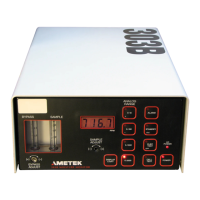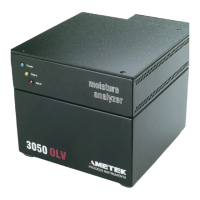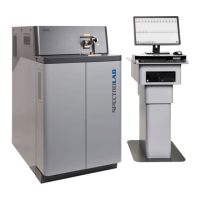5-10 | Model 933S UV Analyzer
Voltage Calibration
The voltage outputs are calibrated at the factory. Most applications will
use current outputs rather than the non-isolated voltage outputs. If the
Customer I/O board is replaced, then the voltage outputs should be cali-
brated if they are used for data acquisition. This is done from the Output
Setup dialog box. Calibration of a voltage output is performed by entering
the measured low-scale (Zero) and full-scale (Span) signals for each out-
put. These values are used to offset the output to the correct values.
To calibrate the voltage outputs:
1. Measure the Zero (low-scale) signal of each output:
a. Click Zero Cal to change its status to On. The status of Normal, Mid-
Scale, and Span Cal should be Off.
b. Connect a voltage meter to Pins 1 and 2 (at J108 on the Customer I/O
board) and measure the voltage of Output 1. Under Voltage Outputs,
enter the value next to Zero (mV), under the first column (Output
1). Place a 250 Ohm resistor in series of the multi-meter for accurate
calibration.
Repeat this step for Output 2 (Pins 3 and 4), Output 3 (Pins 5 and 6),
and Output 4 (Pins 7 and 8), recording the value for each output in
the corresponding field.
c. Click Apply to save the changes.
d. To test the accuracy of the output channels, click Mid-Scale to turn
On this function. Verify the voltage outputs are 3000 mV, ± 5 mV.
e. Click the Zero Cal button to change its status to Off.
2. Measure the Span (full-scale) signal of each output:
a. Click the Span Cal button to change its status to On. The status of
Normal, Mid-Scale, and Zero Cal should be Off.
b. Connect a voltage meter to Pins 1 and 2 (at J108 on the Customer I/O
board) and measure the voltage of Output 1. Under Voltage Outputs,
enter the value next to Span (mV), under the first column (Output 1).
Repeat this step for Output 2 (Pins 3 and 4), Output 3 (Pins 5 and 6),
and Output 4 (Pins 7 and 8), recording the value for each output in
the corresponding field.
c. Click Apply to save the changes.

